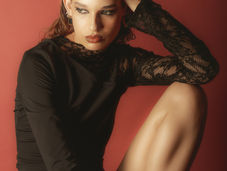Anni Albers at Tate Modern - Review
- Hana Mizukami
- Oct 11, 2018
- 4 min read
11 October 2018 - 27 January 2019
Admission £18 (Advance booking £16)
Concessions £17 (Advance booking £15)
Tate Collective £5
The very first solo exhibition on Anni Albers’s weavings in the UK is taking place in the Eyal Ofer Galleries at Tate Modern from October 11th to January 27th. Albers works from the Bauhaus, Black Mountain College, and New Haven all contribute to her perspective on weavings as one of the types of modern art. She has integrated the ancient medium of weaving with art, culture, history and architecture.
The exhibition is divided into 11 rooms, starting with the traditional and vital textile maker, the loom. The first few pieces were re-woven by the students of the artist, since some of her original works were lost in WWII. Even though the historical context behind her pieces is influential on her and her students’ pieces, she made it seem as if her works were not affected by its negativity nor gloominess. She brought back her utopian image of the timeline as her textiles have a persistent personality throughout different timeframes.
Albers’ works are vividly inspired by her personal environment. In Room 3, where the gauche’s and weavings she made right after she immigrated to the US are displayed, she shows her passion in weavings, as well as her competence in making artworks lively and merging with Latin-American Culture.

The exhibition focused a lot on her way of designing the weavings as class notes from her workshops, and her students’ works were also showcased. In the first few rooms, the designs were more of a solid mathematical geometry. The placement of colours and materials are all planned beforehand; some indicated the number of rows and columns to fill the space in. With structured, repeated patterns, Albers’ expertise in the details of weaving commemorate the modern art perspective.
Even though her weaving, as well as her writing, displayed a perpetual feeling of passion in her career, the exhibition emphasised that she was interested in other fields within the arts, too. There were several standout necklaces made out of ‘found materials,’ such as one with aluminium washers and grosgrain ribbon. Throughout the transition between working as a student in Germany and a teacher in the US, Albers has explored more possibilities to find the unprecedented. ‘Untitled’, one of the first pictorial weavings, is an elegant painting reminiscent of those you can find in elegant hotel rooms, except with textures of linen and wool. I understood that she distinguished between what she calls ‘pictorial weavings’ and textiles for other use, as she seems to be experimenting with materials and colours a lot more with the small weavings designated for wall-hanging.

Anni Albers Card Weaving at Black Mountain College Black Mountain College Photograph Collection, State Archives of North Carolina, Western Regional Archives, Asheville, N.C.
Albers’ curiosity towards cultures and art was portrayed by her artistic interpretations of cultures from Latin-America in her artworks. After she emigrated to the US when her school—the Bauhaus—was forced to shut down, she frequently travelled to Mexico and other parts of Latin-America, such as Peru and Chile, to get a close insight in their art through textiles and crafts. She quoted herself in one of her writings that the ancient Peruvian textiles are “the most imaginative textile inventions in existence,” because textiles to them were once the only communicative tool. The room filled with works inspired by those cultures was vigorous with new textures, shades of colours and structural designs.
The atmosphere in the biggest room of the exhibition changed as colours and interior designs were incorporated. The ‘pictorial weavings’ had the most playful use of colours, and I could picture the process of hand-weaving in my head. Development in Rose I and II are some of Albers’ remarkable pieces woven home in New Haven, Connecticut, though she did not make their connotations any more than ‘only to be looked at’. The essence of her weavings come from the purpose of them, and Tate has set up the venue to reflect her way of thinking, dividing space with textiles. Between Room 5 and 6, there was a translucent wall made out of fabric, which distinguished the two types of weavings displayed. The intention of this was for making the textiles architecture itself, not a supplement to the atmosphere. Anni Albers’ retrospective transformed the room dividers into a representation of endless possibilities and permeability to modern style.
Six Prayers from 1966 to 1967, Albers’ pictorial weaving with relation to religion, was explicitly highlighted in the exhibition, as this piece took up the space of an entire room. Albers was commissioned by the Jewish Museum in New York for the memorial of the six million Jews who were killed during the Holocaust. The piece, consisting of six vertical panels, required a thoughtful observation with the meanings behind the design: it abstractly functions as the Torah scrolls and scripts. In the dim light of Room 7, Six Prayers shows the weight on the artworks, in contrast to pink pictorial weavings from previous rooms.
Although Albers’ works on their own have not been considered prominent in modern art until recently, Tate made sure to reveal the influence the artist had on other people in addition to her dedication on weaving. The intriguing process of weaving is displayed intricately. Albers’ personal connection with weaving, her passion and way of thinking are recurring themes that give this exhibition an intimate touch. Weaving as a skill could be a bit technical to some of the visitors, but looking at Anni Albers’ works is unparalleled when it comes to taking an insight on what modern art is.
























Comments